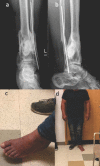Consideration for Limb Salvage in Place of Amputation in Complex Tibial Fracture With Neurovascular Injury: A Case Report
- PMID: 38213861
- PMCID: PMC10777692
Consideration for Limb Salvage in Place of Amputation in Complex Tibial Fracture With Neurovascular Injury: A Case Report
Abstract
High-energy tibial fractures often present with associated soft tissue injuries, including neuro-vascular damage, complicating the treatment decision. A 33-year-old male presented with Gustilo Anderson type IIIA fracture of the left distal tibia and fibula with associated closed calcaneus fracture and tibial nerve transection. Amputation was discussed, but the decision was made for limb salvage with nerve allograft. The patient displayed satisfactory functional recovery at 29 months postoperatively without need for major revision, grafting, arthrodesis, or amputation. This case report provides an example of successful limb salvage utilizing tibial nerve allograft in a complex high-energy lower extremity injury. Level of Evidence: IV.
Keywords: limb salvage; lower extremity trauma; neurovascular injury; open tibial fracture; peripheral nerve allograft; tibial nerve injury.
Copyright © The Iowa Orthopaedic Journal 2023.
Conflict of interest statement
Disclosures: DM discloses speaker’s bureau with Skeletal Dynamics and Axogen, DC discloses education with Smith and Nephew. HN/ WC/JH have nothing to disclose.
Figures


References
-
- Lange RH, Bach AW, Hansen ST, Jr., Johansen KH. Open tibial fractures with associated vascular injuries: prognosis for limb salvage. J Trauma. 1985;25(3):203–208. - PubMed
Publication types
MeSH terms
LinkOut - more resources
Full Text Sources
Medical
